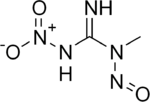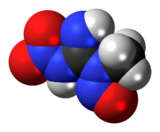Chemistry:Methylnitronitrosoguanidine

| |

| |
| Names | |
|---|---|
| Preferred IUPAC name
N-Methyl-N′-nitro-N-nitrosoguanidine | |
| Other names
1-Methyl-3-nitro-1-nitrosoguanidine
N-Methyl-N-nitroso-N′-nitroguanidine | |
| Identifiers | |
3D model (JSmol)
|
|
| Abbreviations | MNNG |
| ChemSpider | |
| KEGG | |
PubChem CID
|
|
| UNII | |
| |
| |
| Properties | |
| C2H5N5O3 | |
| Molar mass | 147.09 g/mol |
| Appearance | Yellow crystals |
| Melting point | 118 °C (244 °F; 391 K) (decomposes) |
| reacts violently, slowly hydrolysed | |
Except where otherwise noted, data are given for materials in their standard state (at 25 °C [77 °F], 100 kPa). | |
| Infobox references | |
Methylnitronitrosoguanidine (MNNG[2] or MNG, NTG when referred to colloquially as nitrosoguanidine[3]) is a biochemical tool used experimentally as a carcinogen and mutagen.[1] It acts by adding alkyl groups to the O6 of guanine and O4 of thymine, which can lead to transition mutations between GC and AT. These changes do not cause a heavy distortion in the double helix of DNA and thus are hard to detect by the DNA mismatch repair system.
One of the earliest uses of methylnitronitrosoguanidine was in 1985. A group of scientists tested whether or not the chemical composition of methylnitronitrosoguanidine would directly affect the growth of tumors and cancer cells in rats.[citation needed]
In the experiment, the cancer cells from a Japanese cancer patient was injected into 8 rats. The biochemical tool and showed a decline of cancer cells in a few of the rats' bodies.
In organic chemistry, MNNG is used as a source of diazomethane when reacted with aqueous potassium hydroxide.[4]
MNNG is a probable human carcinogen listed as an IARC Group 2A carcinogen.[5]
Stability
MNNG produces diazomethane (known DNA methylating agent) in basic aqueous solutions, and nitrous acid (also mutagenic) in acidic solutions.[6]
References
- ↑ Jump up to: 1.0 1.1 Merck Index, 11th Edition, 6017.
- ↑ Lawley, P. D.; Thatcher, Carolyn J. (1970-02-01). "Methylation of deoxyribonucleic acid in cultured mammalian cells by N-methyl-N′-nitro-N-nitrosoguanidine. The influence of cellular thiol concentrations on the extent of methylation and the 6-oxygen atom of guanine as a site of methylation". Biochemical Journal (Portland Press Ltd.) 116 (4): 693–707. doi:10.1042/bj1160693. ISSN 0306-3283. PMID 5435496.
- ↑ "Forward and reverse mutagenesis in C. elegans". http://www.wormbook.org/chapters/www_frmutagenesis/frmutagenesis.html.
- ↑ T. Howard Black (1983). "The Preparation and Reactions of Diazomethane". Aldrichimica Acta 16 (1). http://www.thblack.com/chemistry/AActa1983_16_3.pdf. Retrieved 2019-02-02.
- ↑ N-METHYL-N'-NITRO-N-NITROSOGUANIDINE (MNNG), International Agency for Research on Cancer
- ↑ Hollaender, Alexander (1971). Chemical Mutagens : Principles and Methods for Their Detection Volume 1. Boston, MA: Springer US. p. 188. ISBN 978-1-4615-8966-2. OCLC 851813793.
 |

